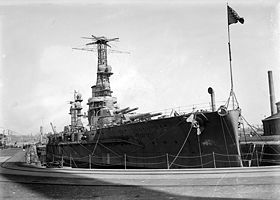Moreno (ship)

|
|
|---|---|

|
|
| Overview | |
| Type | Battleship |
| Shipyard |
New York Shipbuilding Co. |
| Order | 1908 |
| Keel laying | July 9, 1910 |
| Launch | September 23, 1911 |
| delivery | March 1915 |
| Removed from ship register | February 1957 |
| Whereabouts | Sold February 8, 1957 to Boston Metal Co. and scrapped in Japan by Hikari Co. |
| Technical specifications | |
| displacement |
Normal: 27,940 t |
| length |
L pp : 178.3 m |
| width |
30 m |
| Draft |
8.5 m |
| crew |
130 officers and 1,000 men |
| drive |
|
| speed |
22.5 kn |
| Range |
7000 nm at 15 kn |
| Armament |
|
| Armor |
|
| Bunker quantity |
4000 tons of coal and 600 tons of heating oil |
The Moreno was an Argentine battleship and, next to the Rivadavia, the second ship of the Rivadavia class.
First World War and the interwar period
After its completion in the Fore River shipyard on January 15, 1915, the Moreno arrived on May 26 of the same year at the Argentine naval base in Puerto Belgrano . On the way, the ship and crew attended the opening ceremony of the Panama Canal . The Moreno was assigned to the 1st division of the fleet and performed normal fleet service until 1923.
After a general overhaul in the shipyard, she was a school and training ship until the end of the 1930s. In August 1933, the Moreno , accompanied by three destroyers, brought the Argentine President Agustín Pedro Justo on his state visits to Uruguay and Brazil . In 1937 the Moreno paid visits to European fleets together with the Rivadavia and returned to Argentina after a long journey via Madeira.
World War II and post-war period
When the Second World War broke out, the battleship was again in Brazil and could only start the hasty journey home under destroyer protection. Throughout the war, she either patrolled the South Atlantic or was in port. During her entire active time, the Moreno was not involved in a single combat action and only shot grenades during various target practice.
In 1949 the ship was decommissioned and from then on served as a residential ship. In 1955 it became a prison hulk and a year later it was removed from the fleet list. In 1957, the battleship was sold to the Boston Metals Co. for US $ 2,469,660 and towed to Japan - at that time the longest towed trip - to be scrapped.
literature
- Mike J. Whitley: Battleships of World War II . Motorbuch Verlag 2003, ISBN 3-613-02289-3 .